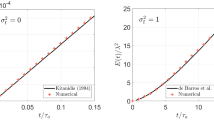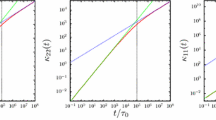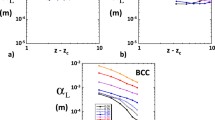Abstract
A technique for modeling contaminant transport based on Markov process theory is developed. Transport is quantified by summing the first two moments of independent random displacements and applying the central limit theorem (CLT) to obtain solute distributions of a Gaussian nature. For non-uniform flow fields the CLT is applied in a streamfunction/equi-travel time space and transforms are used to give concentrations in Cartesian coordinates. Simulations in uniform, radially converging and circular flow fields show the method to be two to three orders of magnitude faster than modeling with the advection-dispersion equation, using a control volume technique.








Similar content being viewed by others
References
Bear J (1961) On the tensor form of dispersion in porous media. J Geophys Res 66:1185–1197
Bear J (1972) Dynamics of fluids in porous media. Dover, Mineola
Bhattacharya RN, Gupta VK (1983) A theoretical explanation of solute dispersion in saturated porous media at the Darcy scale. Water Resour Res 19(4):938–944
Bhattacharya RN, Gupta VK (1990) Application of central limit theorems to solute dispersion in saturated porous media: from kinetic to field scales. In: Cushman J (eds) Dynamics of fluids in hierarchical porous media. Academic, New York, pp 61–96
Ericsson H (1998) A Markov process approach to contaminant transport modeling. Masters thesis, Uppsala University School of Engineering
Frind EO (1987) Modelling of contaminant transport in groundwater—an overview. In: The Canadian Society for Civil Engineering centennial symposium on management of waste contamination of groundwater, Montreal
Hathhorn WE, Charbeneau RJ (1994) Stochastic fluid travel times in heterogeneous porous media. J Hydr Engr ASCE 120(2):134
Kennedy CA, Lennox WC (1995) A control volume model of solute transport in a single fracture. Water Resour Res 31(2):313–322
Kennedy CA, Ericsson H, Lennox WC (1999) Removing the boundaries to efficient groundwater contaminant transport modeling. In: ModelCARE 99, international conference on calibration and reliability in groundwater modelling, Zurich, Switzerland
Kreft A, Zuber A (1978) On the physical meaning of the dispersion equation and its solutions for different initial and boundary conditions. Chem Eng Sci 33:1471–1480
Patankar SV (1961) Numerical heat transfer and fluid flow. Taylor & Francis, New York
Scheidegger AE (1961) General theory of dispersion in porous media. J Geophys Res 66(10):3273–3278
Stratonovich RL (1963) Topics in the theory of random noise, vol 1. Gordon and Breach, New York
Stuart A, Ord K (1994) Kendall’s advanced theory of statistics. Distribution theory, vol 1, 6th edn. Edward Arnold, London
Taylor GI (1921) Diffusion by continuous movements. Proc Lond Mat Soc 2(20)
Author information
Authors and Affiliations
Corresponding author
Rights and permissions
About this article
Cite this article
Kennedy, C., Ericsson, H. & Wong, P.L.R. Gaussian plume modeling of contaminant transport. Stoch Environ Res Ris Assess 20, 119–125 (2006). https://doi.org/10.1007/s00477-005-0021-6
Published:
Issue Date:
DOI: https://doi.org/10.1007/s00477-005-0021-6




